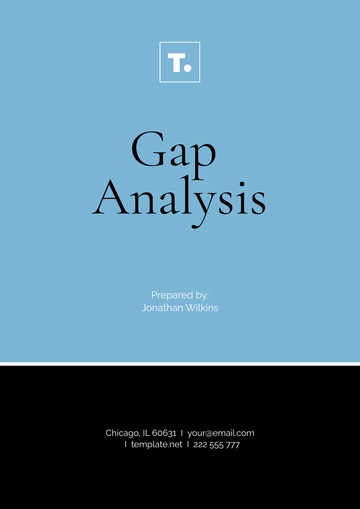Education Gap Analysis
Prepared By : | [Your Name] |
Company : | [Your Company Name] |
Department : | [Your Department] |
I. Executive Summary
Summary of actionable insights for policymakers, educators, administrators, parents, and students: Recommendations include policy changes, educational interventions, and stakeholder engagement strategies.
II. Introduction
A. Background
B. Objectives
III. Methodology
A. Data Collection
Sources of data (e.g., surveys, interviews, assessments)
Student performance data from standardized tests
Surveys of educators, parents, and students
Analysis of demographic and socioeconomic data
Sample size and characteristics: The analysis included data from 5 schools across [Location/Institution].
B. Analysis Techniques
Statistical methods used: Descriptive statistics, regression analysis, and gap analysis techniques were employed to analyze the data.
Tools or software utilized for data analysis: SPSS, Excel, and data visualization tools were used for data analysis.
IV. Findings
A. Overall Education Gap
B. Specific Gap Analysis
Academic Achievement: Disparities in standardized test scores and graduation rates were observed among different demographic groups.
Access to Resources: Disparities in funding, facilities, and technology access were identified between schools in affluent and low-income areas.
Socioeconomic Factors: The analysis found a correlation between socioeconomic status and educational outcomes.
Equity and Inclusion: Disparities in disciplinary actions and access to advanced coursework were observed among diverse student populations.
Teacher Quality and Training: Disparities in teacher qualifications and professional development opportunities were noted.
V. Discussion
A. Interpretation of Findings
Analysis of the root causes behind the identified gaps: Provide an in-depth analysis of the underlying factors contributing to the identified disparities, including socioeconomic, cultural, and institutional factors.
B. Implications
Impact of education gaps on stakeholders: Discuss the implications of the identified gaps on various stakeholders, including students, educators, parents, and the community.
Demographic Group | Average Test Scores | Graduation Rate (%) |
|---|
Low-Income Students | 78 | 85 |
Minority Students | 75 | 82 |
Students with Disabilities | 70 | 75 |
VI. Recommendations
A. Policy Recommendations
Strategies for policymakers to address systemic issues: Provide specific policy recommendations aimed at addressing the root causes of the identified education gaps, such as equitable funding policies, inclusive curriculum development, and targeted support for disadvantaged communities.
School | Total Budget ($) | Per-Pupil Spending ($) |
|---|
School A | $500,000 | $10,000 |
School B | $750,000 | $15,000 |
School C | $400,000 | $8,000 |
B. Educational Interventions
Curriculum Development: Recommend strategies for developing a more inclusive and culturally responsive curriculum that meets the needs of diverse student populations, including integrating multicultural perspectives and real-world applications.
Teacher Training Programs: Propose professional development programs to improve teacher effectiveness and cultural competence, including ongoing training in evidence-based instructional practices and strategies for promoting equity and inclusion.
Resource Allocation: Suggest methods for more equitable resource allocation, such as weighted funding formulas based on student need, targeted grants for underserved schools, and leveraging community partnerships to supplement resources.
Parental and Community Involvement Initiatives: Recommend strategies for increasing parental and community involvement in education, including creating welcoming school environments, providing resources for family engagement, and fostering partnerships with local organizations.
C. Stakeholder Engagement
Suggestions for involving educators, administrators, parents, and students in addressing the education gaps: Outline strategies for engaging stakeholders in the decision-making process, including regular communication, opportunities for input and feedback, and collaborative problem-solving approaches.
VII. Conclusion
Call to action for stakeholders to collaborate in bridging education gaps: Issue a call to action for stakeholders to work together to implement the recommended strategies and monitor progress towards closing the education gaps, emphasizing the shared responsibility for ensuring educational equity and excellence.
Analysis Templates @ Template.net






























